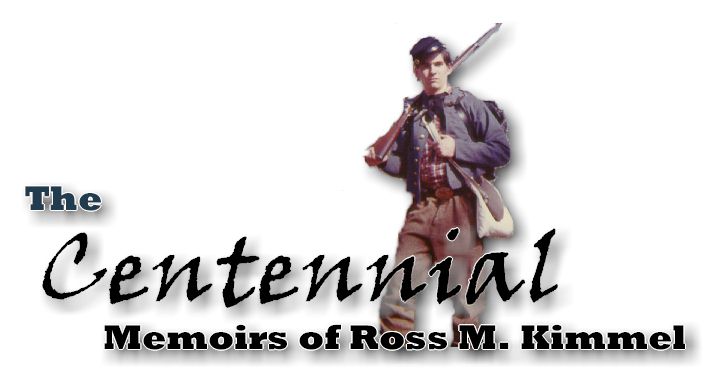
I was fortunate to make the acquaintance of Ross Kimmel while doing research for an article about the true origin of the term "farb"; I entitled it "Who was the Founding Father of Farb?" Several Internet sources told me that Ross Kimmel was knowledgeable about the subject, and was an experienced Centennial reenactor I should get to know. When I contacted Ross, he offered to send me his memoirs of the period, which I read at one sitting. I was convinced that reenactors in general should have this material available to them to better understand the beginnings of the hobby on which we all spend so much time, energy, money and passion. After all, we claim to educate the public about the Civil War, but are often ignorant of our own cultural history. (This is especially true for the newer, younger reenactors).
Ross' memoir is, to my mind, a wonderful piece of writing. Not only does it include accounts of the early rise of what we now call the "authentic" movement, it describes what is probably the very first of the true authentic units, the First Maryland Blackhats, C.S.A. Never mind the fact that there never really was a unit in the Confederate Army so nicknamed, and ignore the early attempts to create uniforms by altering modern clothes. What we have here is youthful enthusiasm and the start of something new. Ross' account also provides vivid and personal descriptions of the first two advocates of uniform authenticity, Gerry Rolph and George Gorman. More than this, however, it is highly readable and entertaining, and has as one of its themes reenacting and living history as a rite of passage for an awkward and impressionable teenager into a self-assured young manhood.
Finally, you may notice, as I did, that this account isn't so much a description of how things have changed in the last forty years, but of how they've essentially stayed the same. Reading Ross' experiences with reenacting personalities, the inevitable break-ups and ego trips, and of the often unintentional hilarity found in this hobby, I was frequently reminded of my own twenty years as a reenactor.
This work is broken into six chapters, each an account of a year of the Centennial. I hope you enjoy this as much as I have! You may contact Ross Kimmel directly by email at rmidkim@aol.com; he's interested in hearing your comments and observations. By the way, this is the same work that was serialized in the Camp Chase Gazette. I called the editor's attention to Kimmel's memoirs, but he never gave me credit in the CCG for leading him to it, the ungrateful wretch. - Jonah Begone
Chapter One: "I See the Elephant" (1960)
Chapter Two: "The Elephant Sees Me" (1961)
Chapter Three: "Trunked and Trod Upon" (1962)
Chapter Four: "Senior Boy at Last" (1963)
Chapter Five: "Hardtack and Coffee" (1964)
"A Day in the Life of a Confederate Soldier" Part One, Part Two.
2017 update: "Someone, whose name is not familiar to me, posted this recently on Facebook. It shows the Black Hats at 1st Manassas in 1961. Burt Kummerow is wearing the havelock and I'm next to him, front rank. John Griffiths is the flagbearer and I can name everyone else except the face partially obscured by the flag. The square rigger behind us is a reproduction of the frigate that David Dixon Porter sailed up Bull Run to support McDowell's flank movement. Of course, as you know, Stonewall's troops sank it and thus the Rebs won the battle." - Ross Kimmel
2016 update: Eisenhower watching the Blackhats at his Gettysburg farm. Ross Kimmel is second from right, front rank, next to Burt Kummerow with dead chicken.
Update, 2014 - Three photos from those early days: Blackhats in 1960, Four Michigan Boys at Gettysburg, 1965, Four Boys at Bentonville, 1965.
All material copyright by Ross M. Kimmel. Used with permission. May not be reproduced without the permission of the author.